Minimizing Dust on the Job
Words: Dan Kamys??May 2014
Saws
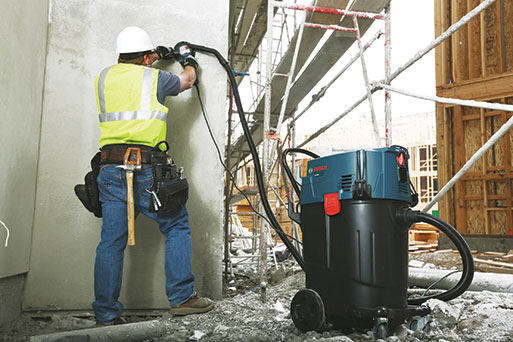 The MK-IXL 5 dust shroud is hooked up to a Ermator S50 HEPA vacuum.
The MK-IXL 5 dust shroud is hooked up to a Ermator S50 HEPA vacuum.
Power equipment manufacturers are working to help mason contractors meet OSHA requirements for silica dust elimination.
By Tom Inglesby
OSHA is revising the PEL (Permissible Exposure Limit) for crystalline silica, and the expected allowable range will be much lower than today. To meet those standards will require two things: a well-planned dust prevention/collection program and equipment than can help you meet the requirements today and in the future.
“I was active in the writing of the California OSHA regulation, and I actually went out and asked a lot of the mason contractors if they had a dust prevention program, or a program that would communicate the issues of dust to their employees," says Brian Delahaut, president of MK Diamond Products, Torrance, Calif. "What I found was that almost 99 percent of them didn’t have any program in place. We’re really behind the eight ball when you start to look at this, and I think that’s one of the biggest challenges.”
|
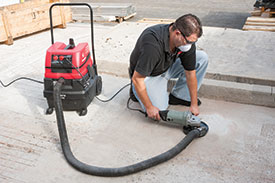 |
|
The MK-IXL 5 dust shroud is hooked up to a Ermator S50 HEPA vacuum.
|
|
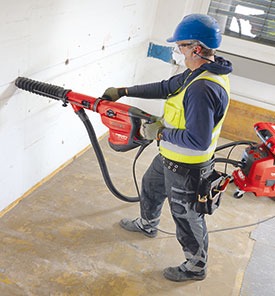 |
|
Shown is the Hilti TE DRS-Y Dust Removal System. |
|
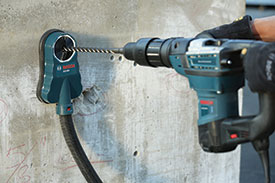 |
|
Shown is the Bosch HDC200 Hammer Dust Collection Attachment. |
|
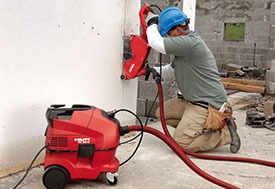 |
|
Shown is the Hilti VC 20-U Dry/wet vacuum cleaner. |
Joel Guth, president of iQ Power Tools, Moreno Valley, Calif., testified before OSHA on this subject in April 2014. While iQ is noted for its masonry saw dust prevention/collection capabilities, his position with OSHA was: “Education, education, education. That is the message I gave to OSHA, and it starts at the top. Contractors need to know and understand the risks and then make choices and develop training programs – work with their insurance companies and their tool producers to have training programs – to teach people the safe and efficient way to use the tools that they have to keep them out of harm’s way.”
Vacuum systems are becoming commonplace and, naturally, they add cost to the product – a factor that Delahaut claims slows down their adoption. But every answer to the dust problem will cost money and avoiding the problem will, eventually, cost even more.
In vacuums, HEPA (High-Efficiency Particulate Air) filters are big right now for dust control. According to Delahaut, “A regular vacuum that doesn’t have a HEPA filter on it is actually doing more harm to the individuals nearby, because the vacuum is filtering out most of the large particles and pushing out the micro-particles. Workers have a chance of getting even more of a dose of silica as a result. So if you go to the Home Depot and buy a general-use shop vac, that’s not really helping.”
Building the vacuum into the system can make a big difference. Guth, who was a mason contractor for 25 years, notes, “We built our equipment to protect our own people on our own jobs, so we designed it to eliminate the dust problem. That, along with education and training, gives contractors a fighting chance to be able to comply and keep their environment safe.
Although masonry saws tend to generate the most dust on the jobsite, they are not alone; grinders and drills also are involved.
“It’s very easy, when you talk about drilling and grinding tools, to just look at dust hoods or dust collection accessories,” says Tim Sparrow, marketing trade manager at Hilti. “But you want to make sure that you always talk about a system, or else you’re not going to get the benefit that you’re looking for.
“For example, we have systems for drilling, attachments that go on the drill to collect all the dust, and what goes with that is our vacuum system,” Sparrow continues. “Too often, you’ll see contractors using a dust hood and a shop vac to extract the dust. Unfortunately, a lot of times that vacuum will get clogged just as you start using it.”
As Delahaut points out, shop vacuums are meant to clean up messes around the jobsite, not for fine dust collection. A clogged vacuum loses suction and can give a false sense of compliance. Workers have to manually knock the filter free of dust, ruining the effect of the dust collection in the first place.
“And, on top of that, the filtration system is typically a paper filter,” Sparrow says, noting that Hilti’s system is more universal. “Our special dust collection vacuum can be set up for HEPA, for wet collection, or for dry collection; we have different filters for all of those. We have an accessory hood that will allow suction around the bit as you drill and a new system – our hollow drill bit system – where the drill bit doesn’t have flutes but holes at the end, between the carbide heads, that suck the dust out as you’re drilling. There’s no dust coming out of the hole.”
Another vacuum system for dust collection on drilling tools was developed by Bosch. According to Craig Wilson, product manager, “Bosch first launched its 1702 vacuum in 1980 and followed it with the Airsweep vacuum series, which provided power tool activation and filter cleaning, increasing user productivity. We continue to look for ways to improve upon dust collection as the PEL requirements for silica dust become more important to the contractor.”
Mitch Burdick, another product manager at Bosch, adds, “Bosch continues to monitor the ongoing development of OSHA requirements for dust collection and prevention.” In May 2014, Bosch will launch an all-new range of dust collection attachments for the complete range of hammers from SDS-plus, all the way up to the breaker hammers.
Your suppliers are working to help you meet the requirements; are you doing your part?
Tom Inglesby, former editor of Masonry, lives and works as a writer in Southern California.
| MCAA Testifies at OSHA Silica Hearings
By Jeff Buczkiewicz |
| On March 31, 2014, the MCAA testified about the impact that the new OSHA silica proposed rule will have on the masonry industry. Rashod Johnson, MCAA engineering consultant, led for MCAA questioning the need for a new silica rule that deviates from the ASTM standard on silica. ??
There were several discrepancies between the two that were discussed. Two major issues were the PEL 100 in the ASTM standard, .50 with a .25 action level in the proposed OSHA standard. The other critical issue was the over-burdensome medical surveillance required in the proposed OSHA standard. The MCAA went on to discuss concerns with the technological feasibility of the new rule and the economic feasibility.
In addition, the MCAA was concerned about the Table 1 option listed in the proposed rule and the complexity and admission of guilt assumed by using the table. Using the table would immediately trigger the need to comply with the medical surveillance required by the proposed standard, and we found that to be very problematic.
The MCAA testified separately from its Construction Industry Safety Council alliance to spotlight the issues unique to the masonry industry. The MCAA plans to file follow-up comments before the end of that filing deadline to add additional concern to the record regarding the proposed rule.
“It is our hope that OSHA will recognize the unique nature of construction (as they always have in previous rules) and come back with a silica rule that separates out construction from general industry,” says Mark Kemp, MCAA chairman.?? Look for more information as the process moves forward.
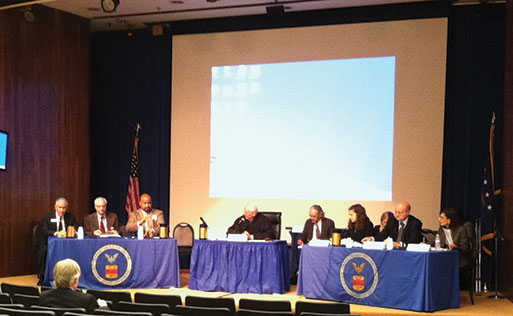 Pictured third from left is Rashod Johnson, MCAA engineering consultant, who led for MCAA questioning the need for a new silica rule that deviates from the ASTM standard on silica.
Pictured third from left is Rashod Johnson, MCAA engineering consultant, who led for MCAA questioning the need for a new silica rule that deviates from the ASTM standard on silica.
Jeff Buczkiewicz is president of the Mason Contractors Association of America (MCAA). He can be reached at jeffb@masoncontractors.org. |
Return to Table of Contents